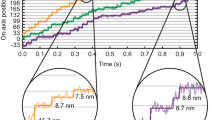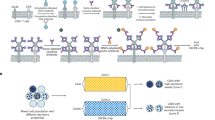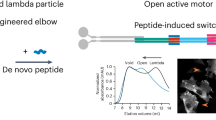Abstract
Kinesins are microtubule-based motors involved in various intracellular transports. Neurons, flagellated cells, and pigment cells have been traditionally used as model systems to study the cellular functions of kinesins. Here, we report silkworm posterior silkgland (PSG), specialized cells with an extensive endomembrane system for intracellular transport and efficient secretion of fibroin, as a novel model for kinesin study. To investigate kinesin-driven intracellular transport in PSG cells, we cloned five silkworm kinesin-like proteins (KLPs), BmKinesin-1, BmKinesin-6, BmKinesin-7, BmKinesin-13, and BmKinesin-14A. We determined their expression patterns by relative real-time PCR and western blotting. Immunofluorescence microscopy verified their colocalization with microtubules. By combining pull-down assays, LC-MS/MS, and western blotting analysis, we identified many potential cargoes of BmKinesin-1 in PSG, including fibroin-containing granules and exuperantia-associated ribonucleoprotein (RNP) complexes. Moreover, BmKinesin-13 overexpression disrupted the microtubule network in BmN cells, which is consistent with a role of Kinesin-13 in regulating microtubule dynamics in other organisms. On the basis of these results, we concluded that PSG might have advantages in elucidating mechanisms of intracellular transport in secretory tissues and could serve as a potential model for kinesin studies.
Similar content being viewed by others
Log in or create a free account to read this content
Gain free access to this article, as well as selected content from this journal and more on nature.com
or
Abbreviations
- Bm:
-
(Bombyx mori)
- BmNPV:
-
(Bombyx mori nucleopolyhedrovirus)
- CBD:
-
(cargo-binding domain)
- Dm:
-
(Drosophila melanoganster)
- ER:
-
(endoplasmic reticulum)
- EGFP:
-
(enhanced green fluorescent protein)
- GST:
-
(glutathione S-transferase)
- KHC:
-
(kinesin heavy chain)
- KLC:
-
(kinesin light chain)
- KLP:
-
(kinesin-like protein)
- MSG:
-
(middle silkgland)
- PCD:
-
(programmed cell death)
- PSG:
-
(posterior silkgland)
- RNP:
-
(ribonucleoprotein)
- RpL3:
-
(ribosomal protein L3)
- UTR:
-
(untranslated region)
- EYFP:
-
(enhanced yellow fluorescent protein)
References
Vale RD, Reese TS, Sheetz MP . Identification of a novel force-generating protein, kinesin, involved in microtubule-based motility. Cell 1985; 42:39–50.
Lawrence CJ, Dawe RK, Christie KR et al. A standardized kinesin nomenclature. J Cell Biol 2004; 167:19–22.
Miki H, Okada Y, Hirokawa N . Analysis of the kinesin superfamily: insights into structure and function. Trends Cell Biol 2005; 15:467–476.
Yildiz A, Tomishige M, Gennerich A, Vale RD . Intramolecular strain coordinates kinesin stepping behavior along microtubules. Cell 2008; 134:1030–1041.
Alonso MC, Drummond DR, Kain S, Hoeng J, Amos L, Cross RA . An ATP gate controls tubulin binding by the tethered head of kinesin-1. Science 2007; 316:120–123.
Teng J, Rai T, Tanaka Y, et al. The KIF3 motor transports N-cadherin and organizes the developing neuroepithelium. Nat Cell Biol 2005; 7:474–482.
Hunter AW, Caplow M, Coy DL, et al. The kinesin-related protein MCAK is a microtubule depolymerase that forms an ATP-hydrolyzing complex at microtubule ends. Mol Cell 2003; 11:445–457.
Rogers GC, Rogers SL, Schwimmer TA, et al. Two mitotic kinesins cooperate to drive sister chromatid separation during anaphase. Nature 2004; 427:364–370.
Tan D, Asenjo AB, Mennella V, Sharp DJ, Sosa H . Kinesin-13s form rings around microtubules. J Cell Biol 2006; 175:25–31.
Goshima G, Nedelec F, Vale RD . Mechanisms for focusing mitotic spindle poles by minus end-directed motor proteins. J Cell Biol 2005; 171:229–240.
Furuta K, Toyoshima YY . Minus-end-directed motor Ncd exhibits processive movement that is enhanced by microtubule bundling in vitro. Curr Biol 2008; 18:152–157.
Fink G, Hajdo L, Skowronek KJ, Reuther C, Kasprzak AA, Diez S . The mitotic kinesin-14 Ncd drives directional microtubule-microtubule sliding. Nat Cell Biol 2009; 11:717–723.
Braun M, Drummond DR, Cross RA, McAinsh AD . The kinesin-14 Klp2 organizes microtubules into parallel bundles by an ATP-dependent sorting mechanism. Nat Cell Biol 2009; 11:724–730.
Hirokawa N, Takemura R . Molecular motors and mechanisms of directional transport in neurons. Nat Rev Neurosci 2005; 6:201–214.
Goldstein AY, Wang X, Schwarz TL . Axonal transport and the delivery of pre-synaptic components. Curr Opin Neurobiol 2008; 18:495–503.
Rosenbaum JL, Witman GB . Intraflagellar transport. Nat Rev Mol Cell Biol 2002; 3:813–825.
Kural C, Serpinskaya AS, Chou YH, Goldman RD, Gelfand VI, Selvin PR . Tracking melanosomes inside a cell to study molecular motors and their interaction. Proc Natl Acad Sci USA 2007; 104:5378–5382.
Wurm FM . Human therapeutic proteins from silkworms. Nat Biotechnol 2003; 21:34–35.
Tashiro Y, Morimoto T, Matsuura S, Nagata S . Studies on the posterior silk gland of the silkworm, Bombyx mori. I. Growth of posterior silk gland cells and biosynthesis of fibroin during the fifth larval instar. J Cell Biol 1968; 38:574–588.
Inoue S, Tanaka K, Arisaka F, Kimura S, Ohtomo K, Mizuno S . Silk fibroin of Bombyx mori is secreted, assembling a high molecular mass elementary unit consisting of H-chain, L-chain, and P25, with a 6:6:1 molar ratio. J Biol Chem 2000; 275:40517–40528.
Xia Q, Zhou Z, Lu C, et al. A draft sequence for the genome of the domesticated silkworm (Bombyx mori). Science 2004; 306:1937–1940.
Mita K, Morimyo M, Okano K, et al. The construction of an EST database for Bombyx mori and its application. Proc Natl Acad Sci USA 2003; 100:14121–14126.
Sasaki S, Tashiro Y . Studies on the posterior silk gland of the silkworm Bombyx mori. VI. Distribution of microtubules in the posterior silk gland cells. J Cell Biol 1976; 71:565–574.
Sasaki S, Nakajima E, Fujii-Kuriyama Y, Tashiro Y . Intracellular transport and secretion of fibroin in the posterior silk gland of the silkworm Bombyx mori. J Cell Sci 1981; 50:19–44.
Ohnishi A, Hull JJ, Matsumoto S . Targeted disruption of genes in the Bombyx mori sex pheromone biosynthetic pathway. Proc Natl Acad Sci USA 2006; 103:4398–4403.
Miao Y, Zhang Y, Nakagaki K, et al. Expression of spider flagelliform silk protein in Bombyx mori cell line by a novel Bac-to-Bac/BmNPV baculovirus expression system. Appl Microbiol Biotechnol 2006; 71:192–199.
Tomita M, Munetsuna H, Sato T, et al. Transgenic silkworms produce recombinant human type III procollagen in cocoons. Nat Biotechnol 2003; 21:52–56.
Chen W, Foss M, Tseng KF, Zhang D . Redundant mechanisms recruit actin into the contractile ring in silkworm spermatocytes. PLoS Biol 2008; 6:e209.
Okano K, Takada N, Kobayashi M, Maekawa H . cDNA structure and characterization of a kinesin-like protein from the silkworm Bombyx mori. Insect Mol Biol 1994; 3:195–200.
Stewart RJ, Pesavento PA, Woerpel DN, Goldstein LS . Identification and partial characterization of six members of the kinesin superfamily in Drosophila. Proc Natl Acad Sci USA 1991; 88:8470–8474.
Lippincott-Schwartz J, Cole NB, Marotta A, Conrad PA, Bloom GS . Kinesin is the motor for microtubule-mediated Golgi-to-ER membrane traffic. J Cell Biol 1995; 128:293–306.
Helenius J, Brouhard G, Kalaidzidis Y, Diez S, Howard J . The depolymerizing kinesin MCAK uses lattice diffusion to rapidly target microtubule ends. Nature 2006; 441:115–119.
Manning AL, Ganem NJ, Bakhoum SF, Wagenbach M, Wordeman L, Compton DA . The kinesin-13 proteins Kif2a, Kif2b, and Kif2c/MCAK have distinct roles during mitosis in human cells. Mol Biol Cell 2007; 18:2970–2979.
Nakagawa T, Tanaka Y, Matsuoka E, et al. Identification and classification of 16 new kinesin superfamily (KIF) proteins in mouse genome. Proc Natl Acad Sci USA 1997; 94:9654–9659.
Kikuchi Y, Mori K, Suzuki S, Yamaguchi K, Mizuno S . Structure of the Bombyx mori fibroin light-chain-encoding gene: upstream sequence elements common to the light and heavy chain. Gene 1992; 110:151–158.
Dagenbach EM, Endow SA . A new kinesin tree. J Cell Sci 2004; 117:3–7.
Hill E, Clarke M, Barr FA . The Rab6-binding kinesin, Rab6-KIFL, is required for cytokinesis. EMBO J 2000; 19:5711–5719.
Kakei M, Iwami M, Sakurai S . Death commitment in the anterior silk gland of the silkworm, Bombyx mori. J Insect Physiol 2005; 51:17–25.
Gindhart JG, Jr, Desai CJ, Beushausen S, Zinn K, Goldstein LS . Kinesin light chains are essential for axonal transport in Drosophila. J Cell Biol 1998; 141:443–454.
Li JY, Wu CF . Perspectives on the origin of microfilaments, microtubules, the relevant chaperonin system and cytoskeletal motors—a commentary on the spirochaete origin of flagella. Cell Res 2003; 13:219–227.
Ni CZ, Wang HQ, Xu T, Qu Z, Liu GQ . AtKP1, a kinesin-like protein, mainly localizes to mitochondria in Arabidopsis thaliana. Cell Res 2005; 15:725–733.
Suzuki Y, Suzuki E . Quantitative measurements of fibroin messenger RNA synthesis in the posterior silk gland of normal and mutant Bombyx mori. J Mol Biol 1974; 88:393–407.
Kindler S, Wang H, Richter D, Tiedge H . RNA transport and local control of translation. Annu Rev Cell Dev Biol 2005; 21:223–245.
Brendza RP, Serbus LR, Duffy JB, Saxton WM . A function for kinesin I in the posterior transport of oskar mRNA and Staufen protein. Science 2000; 289:2120–2122.
Wilhelm JE, Mansfield J, Hom-Booher N, et al. Isolation of a ribonucleoprotein complex involved in mRNA localization in Drosophila oocytes. J Cell Biol 2000; 148:427–440.
Mische S, Li M, Serr M, Hays TS . Direct observation of regulated ribonucleoprotein transport across the nurse cell/oocyte boundary. Mol Biol Cell 2007; 18:2254–2263.
Riechmann V, Ephrussi A . Par-1 regulates bicoid mRNA localisation by phosphorylating Exuperantia. Development 2004; 131:5897–5907.
Wozniak MJ, Allan VJ . Cargo selection by specific kinesin light chain 1 isoforms. EMBO J 2006; 25:5457–5468.
Wang J, Xia Q, He X, et al. SilkDB: a knowledgebase for silkworm biology and genomics. Nucleic Acids Res 2005; 33:D399–D402.
Schultz J, Milpetz F, Bork P, Ponting CP . SMART, a simple modular architecture research tool: identification of signaling domains. Proc Natl Acad Sci USA 1998; 95:5857–5864.
Letunic I, Copley RR, Pils B, Pinkert S, Schultz J, Bork P . SMART 5: domains in the context of genomes and networks. Nucleic Acids Res 2006; 34:D257–D260.
Lupas A, Van Dyke M, Stock J . Predicting coiled coils from protein sequences. Science 1991; 252:1162–1164.
Katoh K, Misawa K, Kuma K, Miyata T . MAFFT: a novel method for rapid multiple sequence alignment based on fast Fourier transform. Nucleic Acids Res 2002; 30:3059–3066.
Kumar S, Tamura K, Nei M . MEGA3: integrated software for molecular evolutionary genetics analysis and sequence alignment. Brief Bioinform 2004; 5:150–163.
Chomczynski P, Mackey K . Short technical reports. Modification of the TRI reagent procedure for isolation of RNA from polysaccharide- and proteoglycan-rich sources. Biotechniques 1995; 19:942–945.
Matsuoka T, Fujiwara H . Expression of ecdysteroid-regulated genes is reduced specifically in the wing discs of the wing-deficient mutant (fl) of Bombyx mori. Dev Genes Evol 2000; 210:120–128.
Livak KJ, Schmittgen TD . Analysis of relative gene expression data using real-time quantitative PCR and the 2(-Delta Delta C(T)) Method. Methods 2001; 25:402–408.
Yamanaka N, Hua YJ, Mizoguchi A, et al. Identification of a novel prothoracicostatic hormone and its receptor in the silkworm Bombyx mori. J Biol Chem 2005; 280:14684–14690.
Acknowledgements
We wish to thank Prof GZ Zhang and Prof ZF Zhang at the Sericultural Research Institute of the Chinese Academy of Agricultural Sciences for B. mori strain and silkworm artificial diet, respectively. This work was supported by the National Natural Science Foundation of China (30670659, 30771086, 30721064), the Major State Basic Research Development Program of China (973 Program) (2006CB500700, 2006CB910700, 2010CB833705), and the National High Technology Research and Development Program of China (863 Program) (2006AA10A119).
Author information
Authors and Affiliations
Corresponding authors
Additional information
(Supplementary information is linked to the online version of the paper on the Cell Research website.)
Supplementary information
Supplementary information, Figure S1
Sequence analysis and cloning strategy. (PDF 157 kb)
Supplementary information, Figure S2
The predicted genomic structures of five KLPs. (PDF 47 kb)
Supplementary information, Figure S3
Percentage of amino acid identity comparison. (PDF 46 kb)
Supplementary information, Figure S4
BmKinesin-14A localization in brain. (PDF 50 kb)
Supplementary information, Figure S5
Production of BmKinesin-1 antibody. (PDF 27 kb)
Supplementary information, Figure S6
Production of BmKinesin-13 antibody. (PDF 23 kb)
Supplementary information, Figure S7
Immunostaining of BmKinesin-1 and BmKinesin-13. (PDF 56 kb)
Supplementary information, Figure S8
Prokaryotic expression of fibroin L-chain and antibody production. (PDF 107 kb)
Supplementary information, Figure S9
The list of identified proteins in GST-BmKinesin-1-CBD pull-down assay. (PDF 161 kb)
Rights and permissions
About this article
Cite this article
Wang, Q., Teng, J., Shen, B. et al. Characterization of kinesin-like proteins in silkworm posterior silkgland cells. Cell Res 20, 713–727 (2010). https://doi.org/10.1038/cr.2010.47
Received:
Revised:
Accepted:
Published:
Issue date:
DOI: https://doi.org/10.1038/cr.2010.47
Keywords
This article is cited by
-
Cab45S promotes cell proliferation through SERCA2b inhibition and Ca2+ signaling
Oncogene (2016)
-
Extracellular calumenin suppresses ERK1/2 signaling and cell migration by protecting fibulin-1 from MMP-13-mediated proteolysis
Oncogene (2015)
-
Calumenin-15 facilitates filopodia formation by promoting TGF-β superfamily cytokine GDF-15 transcription
Cell Death & Disease (2013)



